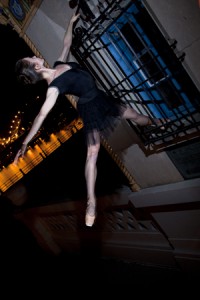by Emily Kate Long

Lately I’ve become increasingly aware of—and increasingly excited by—how much hard science goes into this esoteric and ephemeral art form. The study of technique is, at its roots, a study of kinesiology: physics applied to the human body. Broadening the scientific scope a bit, the emotional, intellectual, and sensory exchanges that happen in the studio and onstage are roughly analogous to biological mutualism. This installment of “Finding Balance” is a look at the fine balance between needs and gifts of the participants in artistic exchange and the trust that’s required to achieve equilibrium—the balance of science with something greater and less measurable.
In biology, mutualistic relationships are categorized as obligative (the relationship is necessary for the survival of one or both participants) or facultative (useful but nonessential for one or both participants). Additionally, the interaction can be described in terms of what is being exchanged between parties: services, resources, or both.
Often the focus is on the relationship between performers and audience, but there are a lot of other players here. Teachers, directors, choreographers, musicians, production staff, and stage crew all make necessary contributions to the presentation of the artistic product, and each derives benefit from the process and the product. The right balance of mutualistic relationships in nature encourages the success of ecosystems. The right balance in professional dance is necessary for the survival and advancement of our art form.
Dancers require opportunities to hone our craft, opportunities to share our art, and individuals or ideas from which to draw inspiration. Classes and rehearsals offer opportunities to perfect movements, and for those things, dancers need a facilitator—a teacher, director, choreographer, or stager. Sharing our art can’t happen without another party present; that’s where the audience comes in. Dancers draw inspiration from a multitude of sources: the audience, the facilitator, the dance itself, the music, fellow dancers, emotions, and past life experiences. Our relationship to all of these things is largely obligative—we cannot intuit technique or dance exclusively by instinct. We cannot be our sole source of motivation and we definitely can’t watch ourselves from across the footlights.
The primary need (arguably, the exclusive need) of the audience is an exceptional sensory and emotional experience, which is delivered directly by the performers, choreographer, musicians, and designers. Of course, this delivery would be impossible without the work of directors, coaches, and crew as well. The audience’s relationship to the performers and facilitators is ambiguous in terms of being essential or simply beneficial—certainly, society at large benefits from art, but only individual audience members (and sometimes not even they) know whether they need to engage in a relationship with dance.
Without performers and an audience, facilitators have no reason to do what they do. Teachers, directors, and choreographers would be full to bursting with technical knowledge, artistic vision, and movement phrases, and all of it would go to waste without performers to deliver or audiences to experience the product. The facilitators have a very clear obligative relationship with performers and audience.
What we have here appears to be an unbalanced ecosystem in terms of services exchanged. Performers and facilitators are on one side, desperately needing an audience to give us purpose and fulfill the creative process, and on the other side, there’s a potential audience that may or may not be aware of, or choose to act on, its need for art. Marketing and development aside, what’s to be done? I think the key is to look closely at the roles of trust and responsibility in the interactions that make performance art what it is.
Trust allows the audience to view our work with openness. It allows performers to fully commit to the execution of work. It allows directors and choreographers to take risks and challenge performers and audiences. Trust, however, is not a get-out-of-jail free card. It cannot decline into a tolerance for mediocrity. The audience has a responsibility to demand the best, but first individuals have a responsibility to get themselves to a theater to be educated and develop personal taste. The audience must be able to trust that what they see will inform them on those points. Performers and facilitators owe their existence as such to the audience and to one another. They must be able to trust that the audience knows that, and they must remain well aware of it themselves, for better or worse. It is a fortunate artist and a fortunate viewer that exists in this type of dance ecosystem.
This circle of trust and acknowledgement of responsibility among audience, dancer, and facilitator assists in balancing and fulfilling the needs of each and all. This is what takes us all from being mere active organisms to aware, compassionate human beings.
Science assists art, but art rises above and beyond science.
Contributor Emily Kate Long began her dance education in South Bend, Indiana, with Kimmary Williams and Jacob Rice and graduated in 2007 from Pittsburgh Ballet Theatre School’s Schenley Program. Ms Long attended Milwaukee Ballet School’s Summer Intensive on scholarship before being invited to join Milwaukee Ballet II in 2007. She also has spent summers studying at Saratoga Summer Dance Intensive, Miami City Ballet, Pittsburgh Ballet Theatre School, Pittsburgh Youth Ballet, and Ballet Chicago.
Ms Long has been a member of Ballet Quad Cities since 2009. She has danced featured roles in Deanna Carter’s Ash to Glass and Dracula, participated in the company’s 2010 tour to New York City, and most recently performed the title role in Courtney Lyon’s Cinderella and the role of Clara in The Nutcracker. Prior to joining Ballet Quad Cities Ms Long performed with Milwaukee Ballet and MBII in Michael Pink’s The Nutcracker and Candide Overture, Petipa’s The Sleeping Beauty and La Bayadére, Balanchine’s Who Cares?, Bournonville’s Flower Festival in Genzano and Napoli, and original contemporary and neoclassical works by Tom Teague, Denis Malinkine, Rolando Yanes, and Petr Zaharadnicek.




